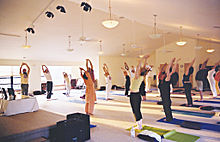Integral Yoga (Satchidananda)
[1] The system includes the practices of asana (yoga postures), pranayama (breathing exercises), and meditation to develop physical and mental stillness so as to access inner peace and joy, which Satchidananda believed was a person's true nature.Satchidananda taught that all religions share essential universal principles and encouraged Integral Yogis to respect and honor the unity in diversity, summarized by his motto, "Truth is one, paths are many.Therefore, Integral Yoga practitioners are encouraged to avoid over-exertion and to take periods of rest and relaxation during their practice, allowing for a more meditative flow.Swami Satchidananda encouraged his students to implement them in daily life, explaining that, "The teachings of Raja Yoga are a golden key to unlock all health, happiness, peace, and joy.The Integral Yogi finds these devotional practices to be external expressions of an internal attitude of surrender, or releasing the ego's selfish wanting.There, Swami Satchidananda, and some of his newly trained students began leading classes for the general public in Hatha, meditation, breath work, and stress management.[18] In August 1968, a group of students took up residence in an apartment in the 500 West End Avenue building to immerse themselves in the yogic lifestyle, forming the first Integral Yoga ashram.Swami Satchidananda's students in New York planned and organized a public lecture on Integral Yoga for him to deliver at Carnegie Hall.[20] Soon after, Satchidananda's weekly lectures on Integral Yoga moved to the Universalist Church on Central Park West, as crowds became larger.Finally, in 1970, a large building in New York's West Village was purchased, which continues to be the site of the Integral Yoga Institute today.This academy operates year-round, offering residential programs that encourage students to immerse themselves in a "yogic lifestyle" based on the teachings of Integral Yoga.


Integral yogaBhaktiJapa yogaSwami Satchidanandapranayamameditationunity in diversityYogavillePatanjaliYoga Sutras of PatanjaliniyamaHatha YogaasanasvegetarianRaja YogaBhakti YogaBhagavad GitakirtanKarma YogaJnana YogamantraConrad RooksPeter MaxWoodstock Music and Art FestivalCarnegie HallYoga AllianceashramsSeigler SpringsBuckingham, VirginiaSivanandaThe New York TimesBroad, William J.Yoga as exerciseList of asanasStanding asanasDownward dogLotus positionMeditation seatsSun SalutationTree poseWarriorDrishtiNamasteVinyāsaHasta VinyasasTeacher trainingBritish Wheel of YogaEuropean Union of YogaAndré Van LysebethTherapyYoga using propsAccessible yogaTrauma-sensitive yogaRestorative YogaYoga nidraInternational Association of Yoga Therapists • Richard MillerJanice GatesCompetitive yogaInternational Day of YogaAsana JournalYoga JournalYoga brickYoga matAngela FarmerHugger MuggerYoga pantsLululemonEarly modern yogaVivekanandaPierre BernardHarmonial gymnastics/yogaMarguerite AgnielMary Bagot StackGenevieve StebbinsPhysical cultureB. C. GhoshK. V. IyerSeetharaman SundaramParamahansa YoganandaAutobiography of a YogiHot yogaScience of yogaSexual abuse by yoga gurusMatthew RemskiYoga and cultural appropriationIn advertisingFor childrenFor womenGeeta IyengarYoga tourismHybridsNaked yogaMindful YogaFrank Jude BoccioAnne CushmanJon Kabat-ZinnCyndi LeePhillip MoffittAcroyogaPaddleboard YogaAerial yogaBeer yogaAmericaYoga for HealthLilias, Yoga and YouBritainLyn MarshallFranceGermanyRussiaSwedenRachel BrathenSelvarajan YesudianYoga Tradition of the Mysore PalaceYoga in Modern IndiaA History of Modern YogaPositioning YogaYoga BodyThe Subtle BodySelling YogaThe Path of Modern YogaRoots of YogaThe Story of YogaEnlighten Up!Breath of the GodsSchools